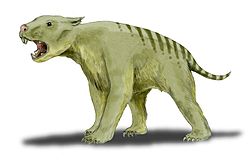| Phascolonus Temporal range: | |
|---|---|
 | |
| Fossil cast at the American Museum of Natural History | |
 | |
| Life restoration | |
| Scientific classification | |
| Domain: | Eukaryota |
| Kingdom: | Animalia |
| Phylum: | Chordata |
| Class: | Mammalia |
| Infraclass: | Marsupialia |
| Order: | Diprotodontia |
| Family: | Vombatidae |
| Genus: | † Phascolonus Owen, 1872 |
| Species | |
| |
| Synonyms | |
| |

Phascolonus is an extinct genus of giant wombat known from the Pliocene [1] and Pleistocene of Australia. There is only a single known species, Phascolonus gigas, the largest wombat ever known to have existed, estimated to weigh as much as 200 kg (450 lb) [2] or 360 kg (790 lb). [3] It was described by Richard Owen in 1859. Phascolomys magnus is a probable junior synonym. [3] P. gigas is distinguished from other wombats by its strap-shaped upper incisors. The cranial roof also is noticeably inwardly depressed. [3] The species was abundant across Australia, with remains having been found in all states except Western Australia. It is suggested to have had a preference for arid and semi-arid inland habitats, with a diet consisting of a high amount of low quality vegetation. Though it likely had wide home-ranges, it probably did not stray far from fresh water sources. [4] Abundant remains have been found in Pleistocene aged deposits from Lake Callabonna in South Australia. [3] Unlike its living relatives, it is unlikely that Phascolonus engaged in burrowing. [5] Phascolonus disappeared during the Late Pleistocene Quaternary extinction event around 50-40,000 years ago, together with many other large Australian animals, following the arrival of humans to the Australian continent. [4] [6] Phylogenetic analysis suggests that is closely related to the other giant wombat genera Ramsayia and Sedophascolomys . [3]

